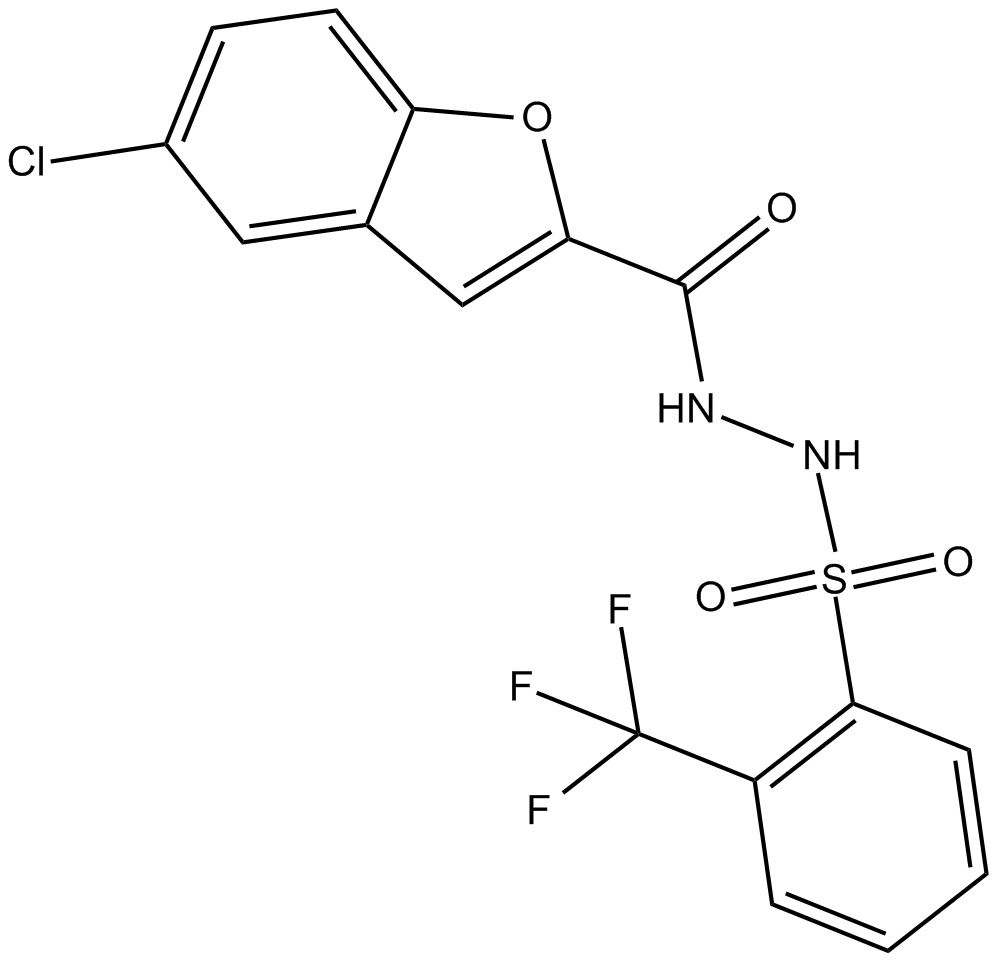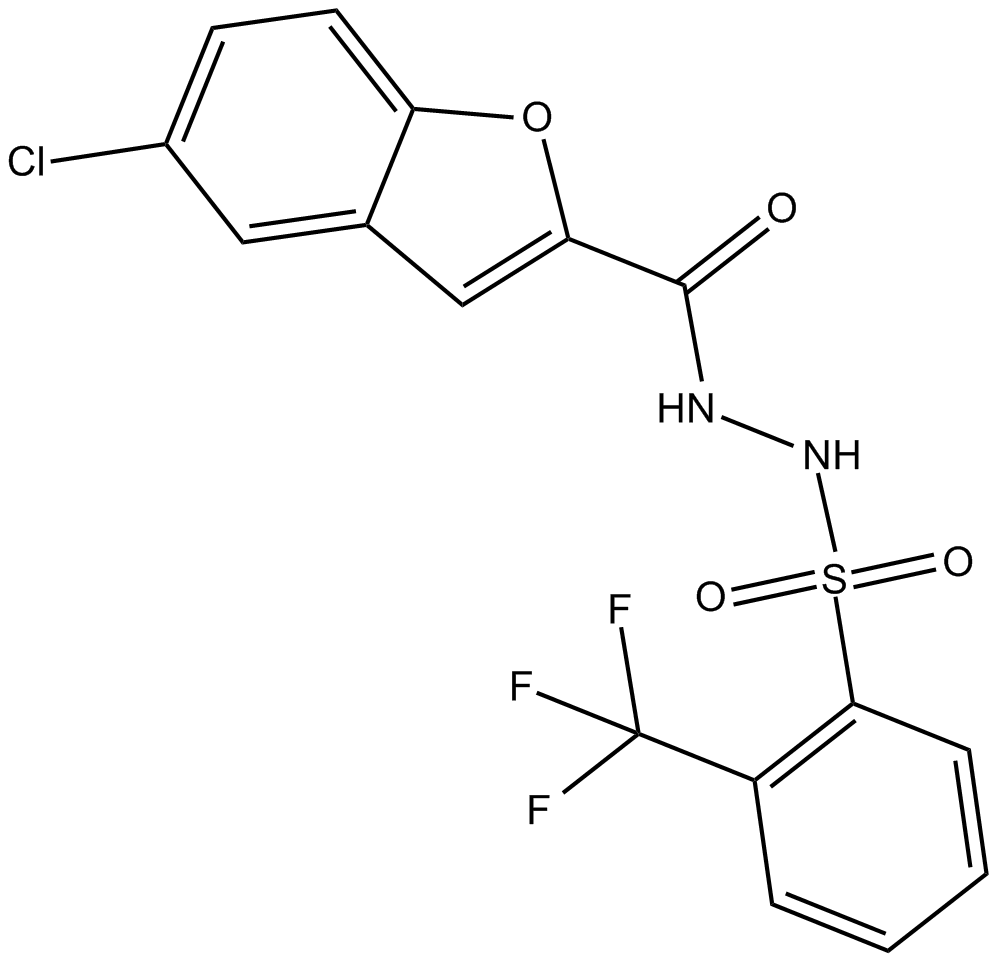BCATc Inhibitor 2
BCATc Inhibitor 2 is an active and selective inhibitor of cytosolic BCAT (BCATc)[1].
Branched-chain amino acid transferases (BCATs) have been implicated in catalyzing reversible transamination of isoleucine, leucine, and valine branched-chain amino acids to their corresponding α-keto acids, generating L-glutamate. It has been identified that there are two forms of BCAT in mammals: mitochondrial BCAT (BCATm) and cytosolic BCAT (BCATc). BCATc is expressed in particular brain region and involved in regulating glutamate synthesis for release during neuronal excitation. Thus, BCATc inhibition may be useful for the treatment of neurodegenerative and behavioral disorders involving disturbances of the glutamatergic system [2].
In vitro: BCATc inhibition is likely to be useful for the treatment of neurodegenerative and other neurological disorders involving disturbances of the glutamatergic system. In the hBCATc assays, BCATc Inhibitor 2 exhibited an IC50 of 0.8 ± 0.05 μM. In a recombinant rat BCATc assay and a crude rat BCATm assay, the IC50 was 0.2 μM ± 0.02 and 3.0 μM ± 0.5 (n=5), respectively. BCATc Inhibitor 2 decreased calcium influx in neuronal cultures with an IC50 of 4.8 ± 1.2 μM (n=4) [1].
In vivo: BCATc Inhibitor 2 blocked calcium influx into neuronal cells following inhibition of glutamate uptake, and demonstrated neuroprotective efficacy in vivo. In Lewis rats, after treatment with 30 mg/kg BCATc Inhibitor 2 (subcutaneous injection), the peak plasma concentration (Cmax) reached 8.28 μg/ml at 0.5 h (tmax). The mean plasma exposure (AUC) value was 19.9 μg h/ml, and the mean terminal half-life ranged from 12 to 15 h, indicating favorable PK parameters of BCATc Inhibitor 2. Daily administration of the mitochondrial neurotoxin, 3-nitroproprionic acid (3-NP) produced striatal lesions and led to motor deficits. Administration of BCATc Inhibitor 2 for 9 days almost completely reversed the effects of 3-NP [1].
References:
[1] Hu L Y, Boxer P A, Kesten S R, et al. The design and synthesis of human branched-chain amino acid aminotransferase inhibitors for treatment of neurodegenerative diseases[J]. Bioorganic & medicinal chemistry letters, 2006, 16(9): 2337-2340.
[2] Brosnan J T, Brosnan M E. Branched-chain amino acids: enzyme and substrate regulation[J]. The Journal of nutrition, 2006, 136(1): 207S-211S.
- 1. Zijuan Wu, Luqiao Wang, et al. "Exploring the significance of PAK1 through chromosome conformation signatures in ibrutinib-resistant chronic lymphocytic leukaemia." Mol Oncol. 2022 Aug;16(16):2920-2935. PMID: 35811334
- 2. Lisa Reynen. "Effects of Branched Chain Amino Acid Transaminase 1inClaudin-low Breast Cancer." University of Guelph. 2019.
| Physical Appearance | A crystalline solid |
| Storage | Store at -20°C |
| M.Wt | 418.8 |
| Cas No. | 406191-34-2 |
| Formula | C16H10ClF3N2O4S |
| Synonyms | Cytosolic Branched-Chain Amino Acid Transferase Inhibitor 2 |
| Solubility | ≤10mg/ml in ethanol;20mg/ml in DMSO;25mg/ml in dimethyl formamide |
| Chemical Name | 5-chloro-2-benzofurancarboxylic acid 2-[[2-(trifluoromethyl)phenyl]sulfonyl]hydrazide |
| SDF | Download SDF |
| Canonical SMILES | O=C(c1cc(cc(cc2)Cl)c2[o]1)NNS(c1c(C(F)(F)F)cccc1)(=O)=O |
| Shipping Condition | Small Molecules with Blue Ice, Modified Nucleotides with Dry Ice. |
| General tips | We do not recommend long-term storage for the solution, please use it up soon. |
| Cell experiment:[1] | |
|
Cell lines |
Neuronal cells |
|
Reaction Conditions |
4.8 μM BCATc Inhibitor 2 (IC50) |
|
Applications |
BCATc Inhibitor 2 blocked calcium influx into neuronal cells following inhibition of glutamate uptake, with an IC50 value of 4.8 ± 1.2 μM. |
| Animal experiment:[1] | |
|
Animal models |
Lewis rats treated for 9 days with the 3-nitroproprionic acid (3-NP) |
|
Dosage form |
30 mg/kg/day Injected subcutaneously for 9 days |
|
Applications |
BCATc Inhibitor 2 (administered for 9 days) was able to almost completely reverse 3-NP-induced motor deficits, as evidenced by improved rotorod and beam walking performance. In addition, histological examination of the brains from these animals demonstrated significant reduction in the number of sections with degenerating neurons. Thus, BCATc inhibition may be useful for the treatment of neurodegenerative and behavioral disorders involving disturbances of the glutamatergic system. |
|
Note |
The technical data provided above is for reference only. |
|
References: 1. Hu LY, Boxer PA, Kesten SR, et al. The design and synthesis of human branched-chain amino acid aminotransferase inhibitors for treatment of neurodegenerative diseases. Bioorganic & Medicinal Chemistry Letters, 2006, 16(9): 2337-2340. |
|
Quality Control & MSDS
- View current batch:
-
Purity = 98.00%
- COA (Certificate Of Analysis)
- MSDS (Material Safety Data Sheet)
- Datasheet
Chemical structure









